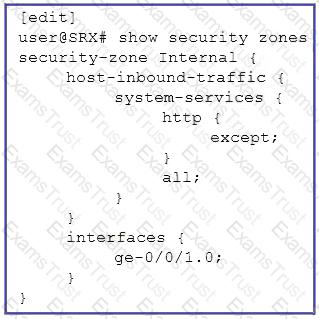Which statement is correct about Web filtering?
Which two statements are correct about IPsec security associations? (Choose two.)
You must monitor security policies on SRX Series devices dispersed throughout locations in your organization using a 'single pane of glass' cloud-based solution.
Which solution satisfies the requirement?
You want to verify the peer before IPsec tunnel establishment.
What would be used as a final check in this scenario?
Which Web filtering solution uses a direct Internet-based service for URL categorization?
What is the order of the first path packet processing when a packet enters a device?
A security zone is configured with the source IP address 192.168.0.12/255.255.0.255 wildcard match.
In this scenario, which two IP packets will match the criteria? (Choose two.)
Which three Web filtering deployment actions are supported by Junos? (Choose three.)
Which two statements are correct about global policies? (Choose two.)
What is the number of concurrent Secure Connect user licenses that an SRX Series device has by default?
You have an FTP server and a webserver on the inside of your network that you want to make available to users outside of the network. You are allocated a single public IP address.
In this scenario, which two NAT elements should you configure? (Choose two.)
When operating in packet mode, which two services are available on the SRX Series device? (Choose two.)
What does the number “2” indicate in interface ge-0/1/2?
What does the number ‘’2’’ indicate in interface ge—0/1/2?
Which statement is correct about Junos security policies?
Click the Exhibit button.

What is the purpose of the host-inbound-traffic configuration shown in the exhibit?
What is the default value of the dead peer detection (DPD) interval for an IPsec VPN tunnel?
You are investigating a communication problem between two hosts and have opened a session on the SRX Series device closest to one of the hosts and entered the show security flow session command.
What information will this command provide? (Choose two.)
When are Unified Threat Management services performed in a packet flow?
Which statement about service objects is correct?
Which two components are part of a security zone? (Choose two.)
What is the correct order in which interface names should be identified?
You are deploying an SRX Series firewall with multiple NAT scenarios.
In this situation, which NAT scenario takes priority?
Which two traffic types are considered exception traffic and require some form of special handling by the PFE? (Choose two.)
Which statement is correct about global security policies on SRX Series devices?
Which two services does Juniper Connected Security provide? (Choose two.)
What is an IP addressing requirement for an IPsec VPN using main mode?
Which two statements are correct about functional zones? (Choose two.)
What is the main purpose of using screens on an SRX Series device?
Which two statements are true about Juniper ATP Cloud? (Choose two.)
Which statement about global NAT address persistence is correct?